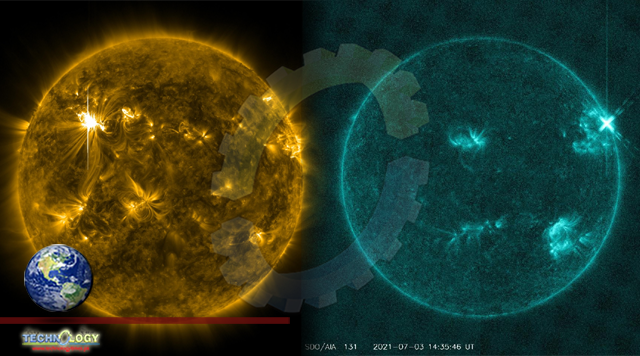Early on Saturday, July 3, Earth saw its first major solar flare for the Solar Cycle 25, an X Class flare that was also the most intense in the last four years.

By Mark Bustos
The solar flare, basically a sudden flash of sharply increased brightness from the Sun, was reportedly from a new and still unnamed sunspot, according to a report from Forbes.
Traveling at the speed of light, the burst of X-ray reached Earth and reacted with the atmosphere, which caused a temporary shortwave radio blackout over the Atlantic ocean and surrounding coastal regions.
The sun erupted with one of the largest solar flares of this solar cycle on March 6, 2012, at 7 PM ET. This flare was categorized as an X5.4, making it the second-largest flare — after an X6.9 on August 9, 2011 — since the sun’s activity segued into a period of relatively low activity called solar minimum in early 2007.
The current increase in the number of X-class flares is part of the sun’s normal 11-year solar cycle, during which activity on the sun ramps up to solar maximum, which is expected to peak in late 2013.
A Rare and Unexpected Event
“Yesterday it did not even exist, highlighting the unpredictability of solar activity. More flares may be in the offing, so stay tuned,” notes astronomer Dr. Tony Philips in a report on the Space Weather website.
Additionally, Dr. Philips shared that it caused a rare phenomenon called “magnetic crochet.” It occurred when the radiation from the X Class solar flare ionized the top layer of the atmosphere, creating currents that flow 60 to 100 kilometers above surface level.
The currents then affect the Earth’s polar magnetic field. As a result of this magnetic crochet, Rob Stammes reports in the same article that the solar flare disturbing all his instruments in Lofoten, Norway. The effects involve a radio burst, an ionospheric disturbance, electrical surges in the ground, and a deflection on the local magnetic field in his area.
Measuring Solar Flares and Solar Cycles
Generally, solar flares are classified as A, B, C, M, or X class, depending on the value of their measured peak flux (in watts per square meter) of the X-rays. This radiation usually has values ranging from 100 to 800 picometers).
This is usually measured by the Geostationary Operational Environmental Satellite (GOES), a set of satellites operated by the NOAA for weather forecasting, storm tracking, and meteorology research.
The recent X Class solar flare is the first major event recorded for the recent Solar Cycle 25, which is the current iteration of an almost periodic 11-year cycle of sunspot activity.
Beginning in 2019, the cycle is expected to last up until 2030. A 2020 news release from NASA explains the predictions made by the Solar 25 Prediction Panel – an international group of experts – that the solar minimum occurred in December 2019, marking the transition between solar cycles.
Its first major solar flare, the July 3 X Class, registered an X1.59, which experts say is a sign that stronger flares might be hitting Earth in the following months. The previous cycle, Solar Cycle 24, gave off a more powerful X9 flare back in 2017.
For Solar Cycle 25, the first C class was recorded on May 29, 2020. The solar activity was observed to be continuously increasing over the following months before coming to an abrupt halt sometime in October. The regular flares returned by November, with an M4.4 flare occurring before the month ended, marking the strongest solar flare before the recent X Class flare.
Originally published at The Science times